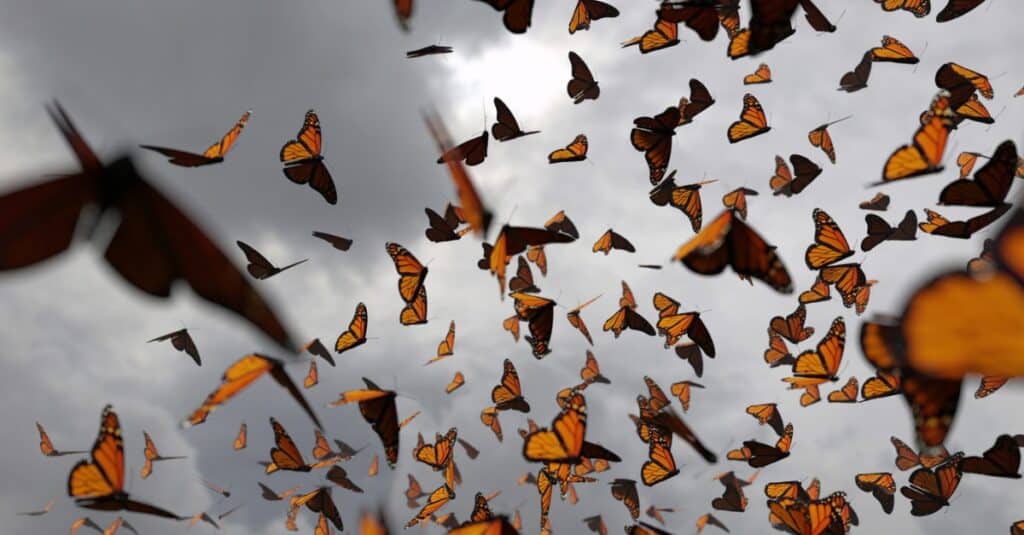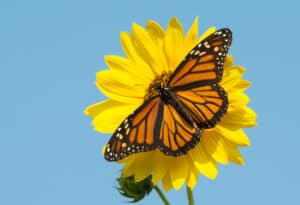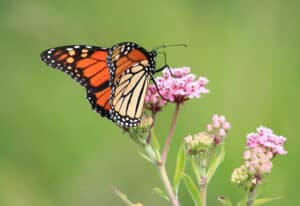The monarch butterfly migration is one of the great wonders of the natural world. Every year millions of them travel immense distances along predetermined monarch butterfly migration routes to escape the frigid weather. The process of spending the winter hunkered down in a single location is known as overwintering. While most butterflies reproduce and overwinter near the same location all year round, monarchs are one of the few species that have a defined annual migratory route from one end of the continent to the other. This article will cover some interesting and important facts about the monarch butterfly migration and overwintering strategy.
Where Do the Monarchs Migrate to?
Monarch butterflies move between two different sites every year: the northern summer site and the southern overwintering site. Monarchs spend the summer season in forests, grasslands, wetlands, and other habitats throughout the northern United States and southern Canada. When the winter arrives, they migrate south in response to changing environmental conditions. Butterflies in the east tend to migrate toward the Sierra Madre Mountains in Mexico, although some find a home in Cuba and Florida as well. The butterflies in the western part of the continent tend to overwinter in California and Baja California. The eastern and western populations are not considered to be separate subspecies, despite their complete isolation from each other.
Altogether, these butterflies can travel hundreds of miles — some as many as 3,000 miles — to their winter homes, stopping at various points along the way to rest or reproduce. The monarch butterfly migration path can occur both overland and over long distances of open water. Small peninsulas and islands are vital for giving them a place to rest when they make the journey over the ocean.
Upon reaching the overwintering site, the butterflies gather together in massive roosts to stay warm. A single tree can contain a cluster of more than 10,000 butterflies. Oyamel trees tend to be among their favorite roosting sites, because the branches have the strength to support their weight, but they can also roost on many different types of trees on the way to the overwintering site, including pine, cedar, and fir. These trees typically have thick canopies that insulate them from falling temperatures. Protection of the oyamel forests is vital to saving the monarch butterflies from a decline in population numbers.

©iStock.com/dottedhippo
How Often Do Monarchs Migrate?
Monarchs migrate once a year for the winter. The timing of this migration is synced with their unusual life cycle, which passes through four generations per year. The first generation of the year is born at some point between March and May. They are the offspring of the previous overwintering generation and may be born at the overwintering site or on the return trip north. When they become mature adults, these butterflies immediately begin flying north along the reverse monarch butterfly migration path. Because of the cold weather, their lifespan lasts up to 40 or 50 days before they reproduce and die.
The second generation of the year usually emerges from the egg as late as June and doesn’t need to travel very far to reach the summer home. Instead, they can devote most of their energy to producing as many offspring as possible. Their lifespan lasts about a month before they reproduce and then die. The third generation is born during the late summer and begins to make some movements back to the south. They also live and reproduce in about a month before dying.
The final generation of the year (also known as the monarch super generation) is born at some point between July and October and completes the full journey south. However, this generation is different from the others in an important way. In response to plummeting temperatures and shortening daylight, these butterflies will temporarily suspend their development so their reproductive organs remain in an immature state. This suspended state of development is known as diapause.
The final monarch super generation will not reproduce until the following spring. Instead, they spend the winter months drinking nectar and clustering in large nighttime roosts for warmth. Altogether, their lifespan can last up to nine months long. When the temperature begins to increase, they will make the trek back to the north and reproduce on the way, although they too die shortly after mating. When the offspring of the monarch super generation reaches adulthood, the entire cycle begins again.
It should be noted that monarch butterflies can only travel as adults. After the larvae are deposited by the mother, they spend their entire time in the same place, feeding exclusively on the milkweed plant of the genus Asclepias. The larvae will take a few weeks to reach adulthood before they can move away from the plant and continue their journey. Therefore, adult butterflies must find milkweed plants along the migratory route in order for the next generation to survive. The adults, by contrast, generally don’t have this problem because they consume nectar instead.
If you would like to help out the monarch butterfly population, planting milkweed is the easiest way to do so. These plants grow wild in open fields, which are becoming more and more scarce. In addition, milkweed is often considered to be a weed and is killed off. Monarchs are wholly reliant on this one plant and it is becoming very rare. Milkweed produces lovely flowers and can be a great addition to a flower garden.
How Do the Monarchs Navigate?
Many theories have been put forward to explain how the butterflies manage to navigate vast distances to and from their overwintering sites every year. There is some evidence to suggest that monarchs use a combination of the magnetic pull of the planet and the position of the sun in the sky combined with the information from their internal clock. Butterflies have an acute vision that can detect certain types of light beyond normal human capabilities. They can even locate the position of the sun on a completely cloudy day. The individual butterflies traveling to or returning from the overwintering sites have never personally been to the destination, so they must have some ingrained sense of where they are going.
Up Next…
- Monarch Butterfly Lifespan: How Long Do Monarch Butterflies Live? It takes 4 generations per year for monarchs to migrate to their winter grounds. Learn more about their life stages here.
- Male vs Female Monarch: What are the Differences? Can you tell which is which? What is different about each gender? Click here to find out.
- Monarch Butterfly Caterpillar: Everything You Need to Know Monarch butterflies require a unique plant for their caterpillars. Find out more here.
The photo featured at the top of this post is © iStock.com/JHVEPhoto
Thank you for reading! Have some feedback for us? Contact the AZ Animals editorial team.







